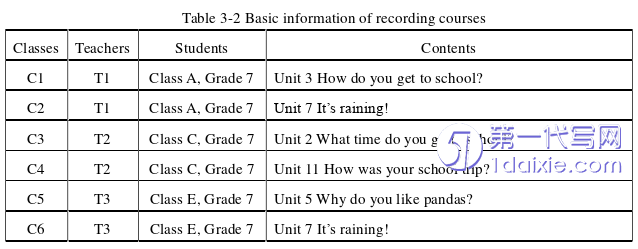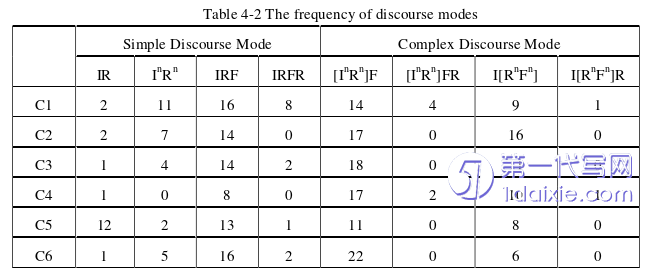本文是一篇英语论文,本研究通过对初中英语课堂的研究,研究者发现了八种师生言语互动的话语模式。其中,IRF、IRFR、[InRn]F和I[RnFn]四种模式对应于李月娥(2002)在大学英语课堂上研究的四种语篇结构。其余四种模式,即IR、InRn、[InRn]FR和I[RnFn]R,是本研究在初中英语课堂上新发现的。
Chapter One Introduction
1.1 Research Background Since the reform and opening up, brilliant achievements have been made in China‘s basic education. However, with the progress of the times, the traditional didactic classroom can no longer meet the needs of the rapid social development. In order to cultivate innovative and inter-disciplinary talents, China has decided to deepen educational reform and comprehensively promote quality education. In the context of the new curriculum reform, some new educational concepts have emerged. Classroom teaching should focus on the interaction between teachers and students to achieve the common development.
The 2001 edition of Basic Education Curriculum Reform Outline (Trial) advocates that teachers should actively interact with students in the teaching process. This can activate the classroom atmosphere and improve the effectiveness of teaching. Teachers should balance the relationship between imparting knowledge and developing ability, and guide students to question in practice, so that students can learn independently. Teachers should also stimulate students‘ motivation for active learning, so that students can achieve all-round development.
The 2011 edition of English Curriculum Standards for Compulsory Education emphasizes that teachers should enhance students‘ subjectivity and allow students to actively participate in classroom activities. Teachers should create various contexts close to real life, and use step-by-step activities for language practice to develop students‘ ability of comprehensive application of language. The creation of the context and the development of language practice activities are both realized through teacher-student interaction.
1.2 Research Purpose
The study aims to understand the actual situation of teacher-student verbal interaction in junior high school English classes, explore the discourse modes of teacher-student verbal interaction, and propose teaching strategies that can improve students‘ participation in classrooms, so as to provide reference for the interactive teaching in junior high school English classes. The concepts of interactive teaching should be updated and the interactive behaviors in the classroom should be improved to enable teachers to carry out interactive teaching more effectively, so that students will learn English better.

In order to improve their professional level, teachers must constantly reflect on their teaching practice, and sum up successful teaching experience and existing problems. This research is based on teachers‘ own teaching practice, and its ultimate purpose is to serve teaching practice. The purpose of this research is to improve the effectiveness of interactive teaching in junior high school English classes and to develop students‘ ability of comprehensive application of English.
Chapter Two Literature Review
2.1 Definitions
Meanings of three key words in this thesis are explained—teacher-student verbal interaction, discourse mode and teaching strategy.
2.1.1 Teacher-Student Verbal Interaction
Interaction refers to the process where at least two people share their ideas and emotions, exchange information and influence each other (Brown, 1994). Classroom teacher-student interaction refers to emotional and cognitive interaction between teachers and students in a specific classroom environment. It aims to achieve teaching goals, using teaching content as the medium (Liu Yao & Dai Haiyan, 2010). In a narrow sense, teacher-student verbal interaction refers to an oral interaction between teachers and students, which is mainly manifested in questioning, answering, evaluating, explaining and so on. In a broad sense, teacher-student verbal interaction includes not only sound speech, but also subvocal speech, which conveys information through eye expressions, facial expressions, gestures, body postures and others (Feng Yujing, 2016).
In this paper, teacher-student verbal interaction is defined as: in the teaching situation of junior high school English classes, teachers and students conduct oral dialogues and exchanges, including classroom questioning, student response and teacher feedback, so as to achieve certain teaching goals. Narrowly defined, teacher-student verbal interaction in this study does not involve subvocal speech. In addition, this study focuses on the process of teacher-student verbal interaction, so there is no specific classification of the behavior of teacher-student verbal interaction.
2.2 Theoretical Basis
This paper contains two theoretical foundation, namely Interaction Hypothesis and Discourse Analysis Model.
2.2.1 Interaction Hypothesis
Long (1985) affirms the importance of comprehensible input to language acquisition, and proposes the interaction hypothesis based on the input hypothesis. Long believes that continuous interactional modification plays an important role in second language acquisition. When the two interacting parties have difficulty in understanding, they can use interpretation, reinterpretation and other communication methods to make the knowledge understood that is not easy to understand, thereby promoting second language acquisition.
Early interaction hypothesis focuses on the role of negotiation of meaning in comprehensible input. Negotiation of meaning refers to the communication between the two sides to overcome difficulties in understanding. Negotiation of meaning can cause interactional modification, thus improving the comprehensibility of language input and effectively promoting language acquisition. Interactional modification refers to the linguistic and semantic adjustment carried out by both sides to promote such communication. In 1996, Long supplemented and developed the interactive hypothesis. He comprehensively combines learners‘ endogenous capacity, selective attention, input, output and interaction, and incorporates them into the interaction hypothesis.
Chapter Three Research Design .............................. 20
3.1 Research Questions ............................................ 20
3.2 Research Subjects ............................................ 20
3.3 Research Methods ................................... 21
Chapter Four Research Findings and Discussion ....................... 25
4.1 Types of Discourse Modes of Teacher-Student Verbal Interaction in Junior High School English Classes ................ 25
4.1.1 The Simple Discourse Mode ...................... 26
4.1.2 The Complex Discourse Mode .................... 30
Chapter Five Conclusion .............................. 71
5.1 Main Findings ............................. 71
5.2 Limitations ..................................... 74
Chapter Four Research Findings and Discussion
4.1 Types of Discourse Modes of Teacher-Student Verbal Interaction in Junior High School English Classes
In the English classroom of junior high school, eight discourse modes of teacher-student verbal interaction are found, and then are described and analyzed by the researcher. Among them, four modes, namely, IRF, IRFR, [InRn]F and I[RnFn], are the same as the four discourse structures found by Li Yue‘e (2002) in college English classes. The other four modes of IR, InRn, [InRn]FR and I[RnFn]R are newly discovered by the researcher in the English classroom of junior high school.
IRF is a fundamental discourse structure. If teachers focus on improving students‘ communicative competence, and if students have more opportunities for interaction, the IRF structure will be extended, and the discourse structure of classroom teaching will be more complex (Li Yue‘e, 2002). Based on this conclusion, the researcher divides these eight discourse modes into two categories, as shown in Table 4-1. Complex discourse modes include four extended variants of the IRF mode. Simple discourse modes include the IRF mode, two simple variants of the IRF mode, and the InRn mode. The InRn mode appears in the process of reading and correcting pronunciation, and cannot trigger students' further thinking on the topic. Therefore, the researcher summarizes this mode as a simple discourse mode.

Chapter Five Conclusion
5.1 Main Findings Through the study of English classes in junior high schools, the researcher has found eight discourse modes of teacher-student verbal interaction. Among them, the four modes of IRF, IRFR, [InRn]F and I[RnFn] correspond to the four discourse structures studied by Li Yue‘e (2002) in college English classes. The rest four modes, namely, IR, InRn, [InRn]FR and I[RnFn]R, were newly discovered in junior high school English classes in this research.
Compared with college students, junior high school students‘ pronunciation intonation has a large room to improve. Therefore, teachers often train students‘ reading skills and correct their pronunciation. In the InRn mode, teachers often ask students to read words, sentences, texts, etc. and correct and demonstrate when students mispronounced. In the process of reading and imitating, students can master correct language and improve their language ability.
Considering the junior high school students‘ weak comprehension ability, teachers will confirm whether students understand when organizing activities or important knowledge points are explained. In IR mode, teachers explain the instruction in details and ask students if it is clear or not. This discourse mode is consultative, allowing students to carry out learning activities after teachers‘ instructions have been understood. In the [InRn]FR mode and the I[RnFn]R mode, teachers explain the answer and make sure that all students have understood it during feedback. What‘s more, students‘ responses act as the final response move R. In this way, teachers can check whether students master this language point or not.
reference(omitted)
